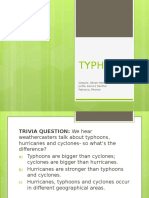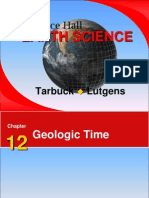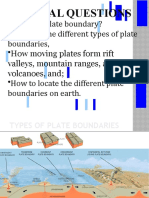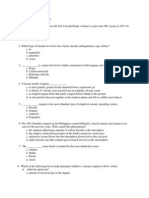Introduction To Volcano
Introduction To Volcano
Uploaded by
api-266403636Copyright:
Available Formats
Introduction To Volcano
Introduction To Volcano
Uploaded by
api-266403636Original Title
Copyright
Available Formats
Share this document
Did you find this document useful?
Is this content inappropriate?
Copyright:
Available Formats
Introduction To Volcano
Introduction To Volcano
Uploaded by
api-266403636Copyright:
Available Formats
VOLCANOES
VOLCANO
A volcano is a rupture on the
crust of a planetary mass
object, such as the Earth,
which allows hot lava,
volcanic ash, and gases to
escape from a magma
chamber below the surface.
What is a volcano?
A volcano is an opening on the surface of a
planet or moon that allows material warmer
than its surroundings to escape from its
interior. When this material escapes, it causes
an eruption. An eruption can be explosive,
sending material high into the sky. Or it can be
calmer, with gentle flows of material.
These volcanic areas usually form mountains
built from the many layers of rock, ash or
other material that collect around them.
Volcanoes can be active, dormant, or extinct.
Active volcanoes are volcanoes that have had
recent eruptions or are expected to have
eruptions in the near future. Dormant
volcanoes no longer produce eruptions, but
might again sometime in the future. Extinct
volcanoes will likely never erupt again.
The Sakurajima Volcano in Japan is one of the most
active volcanoes in the world.
What Causes Volcanoes?
Volcanoes occur when material significantly
warmer than its surroundings is erupted onto
the surface of a planet or moon from its
interior. On Earth, the erupted material can be
liquid rock ("lava" when it's on the surface,
"magma" when it's underground), ash,
cinders, and/or gas. There are three reasons
why magma might rise and cause eruptions
onto Earths surface.
DIAGRAM
Volcanoes on Earth form from rising magma. Magma
rises in three different ways.
What Causes Volcanoes? Cont`d
Magma can rise when pieces of Earth's crust called tectonic
plates slowly move away from each other. The magma rises
up to fill in the space. When this happens underwater
volcanoes can form. Magma also rises when these tectonic
plates move toward each other. When this happens, part of
Earth's crust can be forced deep into its interior. The high
heat and pressure cause the crust to melt and rise as
magma. A final way that magma rises is over hot spots. Hot
spots are exactly what they sound like--hot areas inside of
Earth. These areas heat up magma. The magma becomes
less dense. When it is less dense it rises. Each of the
reasons for rising magma are a bit different, but each can
form volcanoes.
Advantages of a volcano
Provide energy
Volcanoes provide resources for energy
extraction, also called geothermal
resources. Heat from the earth's crust is being
converted to energy. The big advantages to
this type of energy are that it is very clean and
the resources are nearly inexhaustible.
Advantages of a volcano- Cont`d
Fertile soil
When a volcano erupts it throws out a lot of
ash. At short notice this ash can be very harmful
to the environment, but on the long term the ash
layer, which contains many useful minerals, will
be converted to a very fertile soil. Nearly
everywhere volcanoes are located people use the
rich soil for farming. Even after an eruption
people still return because of the fertile soil
around the volcano.
Advantages of a volcano- Cont`d
Tourism
Volcanoes attract millions of visitors every year,
for different reasons. Around the volcano may be
warm bathing lakes, hot springs, bubbling mud
pools and steam vents. Tourism creates jobs in
shops, restaurants, hotels and tourist centers /
national parks. Locals economies can profit from
volcanism throughout the year, whereas skiing,
for example, has only a limited winter season.
Disadvantages of a volcano
Sea - during a volcanic eruption earthquakes happen, and
tsunamis may be created. Also, if it is a volcanic island, the
island may be destroyed, and there is no escape.
Lava flow - these are very slow moving, but destructive as
they cannot be stopped and they set fire to everything in
their path.
Pyroclastic flow - these are impossible to outrun, travelling
at about 300 km/h, and are extremely destructive.
Mudflow - these are mud rivers that have the consistency
of cement, and destroy everything in their path, including
buildings.
Diagram of a Volcano
CHART OF A
VOLCANO
English: Volcano
1. Magma chamber
2. Bedrock
3. Conduit (pipe)
4. Base
5. Sill
6. Branch pipe
7. Layers of ash emitted by the volcano
8. Flank
9. Layers of lava emitted by the volcano
10. Throat
11. Parasitic cone
12. Lava flow
13. Vent
14. Crater
15. Ash cloud
TEACHER`S SAMPLE
Pupils` Research Work
Activity : PAINTING
Activity : PAINTING
Activity : PAINTING
Experiment
You might also like
- Ch01 Earth in ContextDocument33 pagesCh01 Earth in ContextmimiNo ratings yet
- Rock Cycle Comprehension October 1stDocument3 pagesRock Cycle Comprehension October 1stJoy PerezNo ratings yet
- Volcanoes and EarthquakesDocument104 pagesVolcanoes and EarthquakesAlleli AspiliNo ratings yet
- EpicenterDocument24 pagesEpicentermojeebmashalNo ratings yet
- Effects of An Earthquake On LithosphereDocument21 pagesEffects of An Earthquake On Lithosphereanon_247513779100% (1)
- The Structure of The Earth and Plate TectonicsDocument71 pagesThe Structure of The Earth and Plate TectonicsJANICE FRANCELOSONo ratings yet
- Earthquake EpicenterDocument50 pagesEarthquake EpicenterWelms NaderzNo ratings yet
- Oceanic and Continental CrustDocument50 pagesOceanic and Continental CrustMernie Grace DionesioNo ratings yet
- Processes and Landforms Along Plate Boundaries PDFDocument39 pagesProcesses and Landforms Along Plate Boundaries PDFJe Lly Ann100% (1)
- Chapter 2 Section 1 Organisms and Their RelationshipsDocument21 pagesChapter 2 Section 1 Organisms and Their RelationshipsDwayne CordesNo ratings yet
- DIVERGENT BOUNDARY (Divergence of Plates) Divergent Boundaries Occur When Two PlatesDocument5 pagesDIVERGENT BOUNDARY (Divergence of Plates) Divergent Boundaries Occur When Two Platesdaisy sorianoNo ratings yet
- Continental DriftDocument15 pagesContinental DriftAndrea BaluyotNo ratings yet
- Volcanoes, Its Eruption, Types, Geographical Distribution & ProductsDocument3 pagesVolcanoes, Its Eruption, Types, Geographical Distribution & ProductsIzhar JiskaniNo ratings yet
- Seismic WavesDocument39 pagesSeismic Wavessampatryk.otazaNo ratings yet
- Use This! Earth and Earth SystemDocument48 pagesUse This! Earth and Earth SystemPrincess Jaymee Suarez100% (2)
- Geology and The EarthDocument3 pagesGeology and The EarthSHENIVEL BANTENo ratings yet
- Q1 M1 PPT Layers of The EarthDocument97 pagesQ1 M1 PPT Layers of The EarthMarilyn LaquindanumNo ratings yet
- Volcanoes!: Introduction Unit by Ms. GreenDocument15 pagesVolcanoes!: Introduction Unit by Ms. GreenErikaNo ratings yet
- Continental Drift TheoryDocument30 pagesContinental Drift TheoryClaudyne Trixie UyNo ratings yet
- Q4 - 1ST Summative Test Science 7Document2 pagesQ4 - 1ST Summative Test Science 7Aj De CastroNo ratings yet
- Landforms PowerpointDocument21 pagesLandforms PowerpointJhaypee SorianoNo ratings yet
- Earth and Its SubsystemsDocument9 pagesEarth and Its SubsystemsRalph EspejoNo ratings yet
- Plate Boundaries:: Convergent, Divergent and Transform Plate BoundaryDocument22 pagesPlate Boundaries:: Convergent, Divergent and Transform Plate Boundaryjal bayaniNo ratings yet
- Earth SubsystemDocument6 pagesEarth SubsystemXenia Mae FloresNo ratings yet
- Earth and PlateTectonicsDocument32 pagesEarth and PlateTectonicsAmy Sara100% (1)
- Typhoon GaDocument25 pagesTyphoon GaKeirvnz Dexther JurillaNo ratings yet
- ExtinctionsDocument20 pagesExtinctionsapi-340406981No ratings yet
- Learning Activity Worksheets Grade 11 - Earth ScienceDocument8 pagesLearning Activity Worksheets Grade 11 - Earth ScienceMaria AnnaNo ratings yet
- Earth ScienceDocument32 pagesEarth ScienceJosebeth CairoNo ratings yet
- EnvSci CH 4 PPT Organization of LifeDocument49 pagesEnvSci CH 4 PPT Organization of LifeChristine Sena0% (1)
- Group 2 WordDocument12 pagesGroup 2 WordJhyrelle A. MarquezNo ratings yet
- Lesson 5. Endogenic ProcessesDocument24 pagesLesson 5. Endogenic ProcessesKaseylene CabansagNo ratings yet
- Earthquakes-And-Faults PPT 2014Document33 pagesEarthquakes-And-Faults PPT 2014api-269185515No ratings yet
- Volcanoes, Magma & PlutonsDocument37 pagesVolcanoes, Magma & Plutonswonder-chef-4677100% (1)
- Worksheet 04Document5 pagesWorksheet 04Kartavya Jhunjhunwala 9ANo ratings yet
- Lab Report Earthquakes Seismic Slinky Spring1Document4 pagesLab Report Earthquakes Seismic Slinky Spring1Renee Dwi Permata MessakaraengNo ratings yet
- Continental Drift and Plate Tectonics Part 1Document5 pagesContinental Drift and Plate Tectonics Part 1Jakie UbinaNo ratings yet
- Ologic TimeDocument41 pagesOlogic TimeChristine ValerioNo ratings yet
- VOLCANOESDocument40 pagesVOLCANOESQueenie Bars OgirdorNo ratings yet
- MagmaDocument22 pagesMagmaSherren NalaNo ratings yet
- Plate Tectonics WsDocument2 pagesPlate Tectonics WsMariana Lopez0% (1)
- The Earth's Layers From Least To Most DenseDocument3 pagesThe Earth's Layers From Least To Most DenseAnnabelia NavarroNo ratings yet
- Geologic Processes and HazardsDocument33 pagesGeologic Processes and HazardsJaime Bongbonga Jr.No ratings yet
- Why The Earth's Interior Is HotDocument2 pagesWhy The Earth's Interior Is HotJason YaraNo ratings yet
- Geologic Time ScaleDocument12 pagesGeologic Time ScaleTwinkle B. Esteves100% (1)
- 1 4 Sea Floor SpreadingDocument20 pages1 4 Sea Floor SpreadingNeil De Guzman100% (1)
- Seafloor SpreadingDocument33 pagesSeafloor SpreadingSoulnimexNo ratings yet
- Four Subsytems of The EarthDocument31 pagesFour Subsytems of The EarthJenny-Lyn Duran100% (1)
- Group 3 PetrologyDocument132 pagesGroup 3 PetrologyDELOS SANTOS GERALDNo ratings yet
- EARTH SCIENCE. Lesson 1 - Universe & Solar SystemDocument65 pagesEARTH SCIENCE. Lesson 1 - Universe & Solar SystemJeydibi MharjomNo ratings yet
- Rock Behaviors Under StressDocument16 pagesRock Behaviors Under StressInvictusNo ratings yet
- Plate Tectonics PPDocument30 pagesPlate Tectonics PPdazwerk123No ratings yet
- Plate BoundariesDocument24 pagesPlate Boundariesnanno manoban100% (1)
- Relationship Among Living OrganismsDocument25 pagesRelationship Among Living OrganismsJean Claudine MandayNo ratings yet
- Lesson 2 PPT OneDocument40 pagesLesson 2 PPT OneJason AlbertoNo ratings yet
- Layers of The EarthDocument2 pagesLayers of The Earthtorebsuico100% (1)
- Earth's CrustDocument21 pagesEarth's CrustGraham John LuCenaNo ratings yet
- Plate Tectonics Pt3 VolcanoesDocument17 pagesPlate Tectonics Pt3 VolcanoesChristle NgoveNo ratings yet
- Plate Tectonics Pt3 VolcanoesDocument16 pagesPlate Tectonics Pt3 VolcanoesDemon bbyNo ratings yet
- Roi2 e 102 Volcano Themed Cloze Test Activity Sheets Ver 3Document3 pagesRoi2 e 102 Volcano Themed Cloze Test Activity Sheets Ver 3dukespecialNo ratings yet
- What Is A Volcanic Eruption?: The Formation of MagmaDocument6 pagesWhat Is A Volcanic Eruption?: The Formation of MagmaMangesh KumharNo ratings yet
- Worksheet For Ielts 4.5Document166 pagesWorksheet For Ielts 4.5thao.apple2003No ratings yet
- Hazard Assessment ReportDocument6 pagesHazard Assessment ReportMeanne AzucenaNo ratings yet
- Mayon Volcano Eruption, 1984. An Example of Pyroclastic Flow EventDocument15 pagesMayon Volcano Eruption, 1984. An Example of Pyroclastic Flow EventShiela Lumbaga - CayaNo ratings yet
- Earth and Life Science. Chapter 3Document17 pagesEarth and Life Science. Chapter 3veronicaNo ratings yet
- Final Lesson Plan in Science 6 GDDocument14 pagesFinal Lesson Plan in Science 6 GDrandy alvaroNo ratings yet
- DRRR-Week 3Document5 pagesDRRR-Week 3Ren Andaleon CortezNo ratings yet
- EspringerDocument40 pagesEspringerAnonymous lwLoRrFaNo ratings yet
- VOLCANOESDocument102 pagesVOLCANOESDaryl FCNo ratings yet
- Chapter 7 Multiple ChoiceDocument8 pagesChapter 7 Multiple ChoiceIesha ClarkNo ratings yet
- Geo 1Document21 pagesGeo 1suhani.khandelwalNo ratings yet
- Science 6 Q4 Week 1 Day 1Document25 pagesScience 6 Q4 Week 1 Day 1Jayral PradesNo ratings yet
- Introductionto Geomorphic ProcessDocument43 pagesIntroductionto Geomorphic ProcessSai PraveenyaNo ratings yet
- Volcanoes EarthquakeDocument83 pagesVolcanoes EarthquakeMeshal M ManuelNo ratings yet
- Learning Plan 3.1Document4 pagesLearning Plan 3.1Shielo Marie CardinesNo ratings yet
- Ntroduction To Physical Volcanology and Volcanic Textures: Short CourseDocument46 pagesNtroduction To Physical Volcanology and Volcanic Textures: Short CourseWilder Cortez FloresNo ratings yet
- Volcanos PDFDocument76 pagesVolcanos PDFDemiana SamuelNo ratings yet
- KrakatoaDocument1 pageKrakatoagohNo ratings yet
- Mueller 2011 - The Porosity of Pyroclasts As An Indicator of Volcanic ExplosivityDocument7 pagesMueller 2011 - The Porosity of Pyroclasts As An Indicator of Volcanic ExplosivityJuan TurraNo ratings yet
- G9 Science Q3 - Week 2 - How Volcanoes-EruptDocument96 pagesG9 Science Q3 - Week 2 - How Volcanoes-EruptLorie Ann RatunilNo ratings yet
- DRRRM Module Lesson 7-8Document15 pagesDRRRM Module Lesson 7-8Naomi BelonioNo ratings yet
- Grade 9 3rd Periodical ExaminationDocument5 pagesGrade 9 3rd Periodical ExaminationReymart VillapeñaNo ratings yet
- NSTP Summary of ReportsDocument12 pagesNSTP Summary of ReportsJan Marinel A. SerinoNo ratings yet
- Ancient History Notes - Pompeii HerculaneumDocument23 pagesAncient History Notes - Pompeii HerculaneumDesmond MartiniqueNo ratings yet
- Word FormDocument6 pagesWord FormTuan MinhNo ratings yet
- Geological Background of Mount Sumbing Central Java IndonesiaDocument21 pagesGeological Background of Mount Sumbing Central Java Indonesiajames_frankNo ratings yet
- Q3 WORKSHEET NO. 2 - Last Topic For VolcanoesDocument2 pagesQ3 WORKSHEET NO. 2 - Last Topic For VolcanoesMaybelene OrpiadaNo ratings yet
- Strategic Intervention Material VolcanoDocument26 pagesStrategic Intervention Material VolcanoShena Jalalon Peniala100% (2)
- 4.5 Monitoring Volcanoes and Predicting Eruptions - Physical GeologyDocument5 pages4.5 Monitoring Volcanoes and Predicting Eruptions - Physical Geologysoumitra karNo ratings yet

























































































